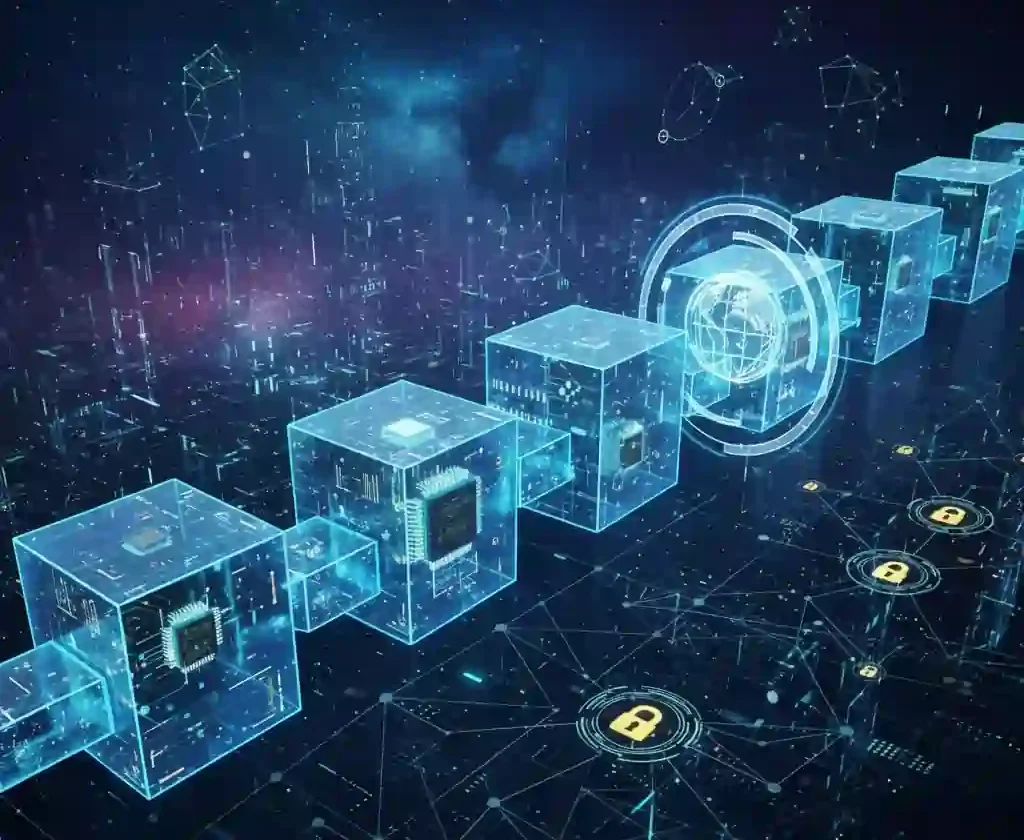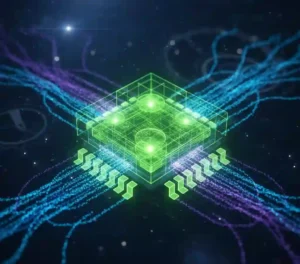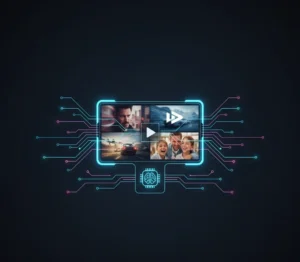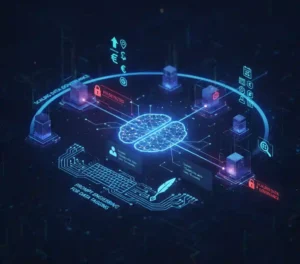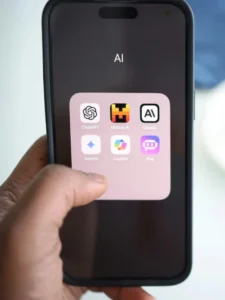Hey there, aspiring tech trailblazer. Imagine waking up to a world where your code doesn’t just run on servers – it powers global finance, art ownership, and even supply chains that span continents. That’s the magic of blockchain. But getting there? It’s not about chasing hype. It’s about a solid blockchain developer roadmap that turns confusion into confidence.
Right now, the blockchain market is exploding. Experts predict it’ll surge from $31.18 billion in 2025 to a whopping $393.42 billion by 2032, growing at a compound annual rate of over 43%. That’s not just numbers – it’s opportunity knocking. Developers who nail blockchain fundamentals today are landing six-figure gigs tomorrow. Whether you’re a web dev dipping your toes or a total newbie, this guide is your no-fluff path forward. We’ll break it down into 10 practical steps, packed with tips, real examples, and even a case study or two to keep things real.
Stick around, and by the end, you’ll have a clear plan to build your first decentralized application. Let’s dive in , you’ve got this.
Table of Contents
Step 1: Grasp Blockchain Fundamentals – The Bedrock of It All
Before you code a single smart contract, you need to understand what makes blockchain tick. Think of it like learning the rules of chess before playing a tournament. Blockchain fundamentals aren’t optional; they’re your foundation.
What Exactly Is Blockchain?
At its core, blockchain is a distributed ledger that records transactions across a network of computers. No single entity controls it – that’s the beauty. It started with Bitcoin in 2008, but today? It’s everywhere from voting systems to music royalties.
Key perks? Immutability (once data’s in, it stays), transparency (anyone can verify), and security through cryptography. But here’s a fun fact: over 80% of banks are experimenting with blockchain for cross-border payments, cutting fees by up to 40%. Crazy, right?
Core Concepts You Can’t Skip:
Don’t just memorize – experiment. Here’s a quick hit list:
- Decentralization: Power to the people, not the bosses. No middleman means faster, cheaper ops.
- Consensus Mechanisms: Proof-of-Work (like Bitcoin’s mining) vs. Proof-of-Stake (Ethereum’s greener shift). Pro tip: Start with videos on how Ethereum 2.0 slashed energy use by 99.95%.
- Cryptography Basics: Hash functions and public-private keys. Play around with tools like OpenSSL to sign a message – it’ll click fast.
- Forks and Interoperability: Understand hard forks (like Ethereum Classic split) and bridges between chains.
Actionable tip: Spend a weekend reading “Mastering Bitcoin” by Andreas Antonopoulos. It’s free online and demystifies the jargon without drowning you in math.
By nailing these blockchain fundamentals, you’re not just learning – you’re thinking like a dev who builds unbreakable systems.
Step 2: Dive into Cryptocurrencies and Wallets – Your Digital Vault
Currencies are blockchain’s killer app. Bitcoin’s market cap hovers around $1 trillion, but altcoins like Ethereum power smart contracts. Get comfy here early.
Set up a wallet like MetaMask. It’s your gateway – think of it as a browser extension that holds your keys (not your coins, remember?). Practice sending test ETH on a faucet like Ropsten.
Real-world nudge: Ever wonder why remittances cost $25 billion in fees yearly? Blockchain wallets slash that to pennies. Tools like Trust Wallet make it seamless for users in developing countries.
Tip: Track your first transaction on Etherscan. Seeing it live? Pure adrenaline.
Step 3: Master Consensus Protocols – The Heartbeat of Networks
Consensus is how nodes agree on truth without a boss. Proof-of-Work? Energy-hungry but secure. Proof-of-Stake? Efficient, with validators staking coins.
Explore Solana’s Proof-of-History – it processes 65,000 TPS, dwarfing Ethereum’s 15. Why care? As a dev, you’ll pick protocols for your chain’s needs.
Hands-on: Simulate a simple consensus in Python using libraries like hashlib. It’ll show why Byzantine Fault Tolerance matters in real attacks.
Step 4: Explore Major Blockchains – Pick Your Playground
Not all chains are equal. Ethereum’s the OG for smart contracts, but Polygon scales it affordably. Solana? Speed demon for gaming dApps.
- EVM-Compatible: Ethereum, Binance Smart Chain, Avalanche. Learn one, adapt to all.
- Non-EVM: Solana (Rust-based), TON (Telegram’s beast).
Start with Ethereum – 70% of dApps live there. Install Geth node and sync a testnet. Feels clunky? That’s growth.
Case study teaser: We’ll hit a big one later, but for now, know Polygon saved gas fees for millions in DeFi.
Step 5: Jump into Smart Contract Development – Where the Magic Happens
Now, the fun part: smart contract development. These are self-executing code on blockchain – like vending machines, but for trustless deals.
Choose Your Language: Solidity First:
Solidity’s the go-to, readable like JavaScript. Write a simple “Hello World” contract:
pragma solidity ^0.8.0;
contract HelloWorld {
string public greet = "Hello, Blockchain!";
}
Deploy it on Remix IDE – free, no setup.
Testing and Security: Don’t Skip This:
80% of hacks stem from contract bugs. Use Hardhat for tests, Slither for audits.
- Unit tests: Check functions solo.
- Fuzz testing: Throw random inputs with Echidna.
- Common pitfalls: Reentrancy (remember The DAO hack? $50M gone).
Tip: Follow OpenZeppelin’s templates – they’re battle-tested for ERC-20 tokens.
Step 6: Build Decentralized Applications – From Idea to Launch
dApps are smart contracts + user interfaces. Think Uniswap: Swap tokens without banks.
Frontend and Backend Basics:
- Frontend: React with ethers.js. Hook MetaMask for wallet connect.
- Backend: Node.js or Python for off-chain logic.
- Architecture: Event-driven – listen for contract events.
Example: Build a voting dApp. Users stake tokens to vote; winners get rewards. Deploy on Polygon for cheap gas.
Security checklist:
- Input validation everywhere.
- Use multisig wallets for funds.
- Monitor with Tenderly.
Pro move: Integrate IPFS for decentralized storage – no AWS downtime worries.
Step 7: Tackle Blockchain Scaling Solutions – Go Big or Go Home
Scaling’s the Achilles’ heel. Ethereum handles 15 TPS; Visa does 24,000. Enter Layer 2.
Layer 2 Magic:
- Optimistic Rollups: Arbitrum – assume honest, challenge fraud.
- ZK Rollups: StarkNet – math proofs for privacy.
- State Channels: Off-chain for micropayments.
Polygon’s zkEVM hit 2,000 TPS in tests.
Tip: Prototype a payment channel in Go. Send “messages” off-chain, settle on-chain. Scalability unlocked.
Sidechains like Binance? Easy bridge, but watch security.
Step 8: Essential Tools and Node Services – Your Dev Kit
No lone wolf here. Alchemy or Infura for nodes – free tiers rock.
- IDEs: VS Code with Solidity extension.
- Frameworks: Foundry for Rust fans; Truffle for JS lovers.
- Version Control: Git + GitHub. Branch per feature.
Quick win: Set up a CI/CD pipeline with GitHub Actions to auto-deploy contracts.
Step 9: Real-World Case Studies – Lessons from the Trenches
Theory’s cool, but stories stick. Let’s unpack two.
Walmart’s Supply Chain Revolution:
Walmart partnered with IBM on Hyperledger Fabric to trace food from farm to shelf. A mango’s journey? Tracked in seconds, not days. Result? E. coli outbreaks cut from weeks to minutes. Sales up 10%, waste down. Lesson: Blockchain shines in traceability – apply it to your dApp for real impact.
Maersk’s TradeLens – Shipping Smarts:
Maersk and IBM built TradeLens on blockchain for global shipping docs. Paperwork delays? Slashed 40%. Over 100M shipments processed, saving billions in fraud. For devs: Focus on interoperability – their API integrations were key.
These aren’t outliers. DeFi’s TVL hit $100B in 2024. Your next project could join them.
Step 10: Launch, Iterate, and Join the Community – The Long Game
Deployed? Congrats! But monitor with Dune Analytics. Iterate based on user feedback.
Join Discord (like Ethereum’s) or Reddit’s r/ethdev. Share your GitHub repo – feedback’s gold.
Career tip: Contribute to open-source like OpenZeppelin. Landed me my first blockchain gig.
Actionable Tips to Accelerate Your Journey
- Daily Habit: Code 30 mins on LeetCode’s crypto problems.
- Project Ladder: Week 1: Simple contract. Month 1: Full dApp. Quarter 1: Contribute to a protocol.
- Certifications: ConsenSys Academy for Solidity badges.
- Network: Attend ETHDenver , virtual tickets are cheap.
- Avoid Burnout: Balance with non-tech reads like “The Infinite Machine.”
Track progress in a Notion board. Small wins build momentum.
There you have it – your blueprint to dominate blockchain. This isn’t just a roadmap; it’s your launchpad. Grab that coffee, fire up VS Code, and start step one today. What’s your first project idea? Drop it in the comments – let’s chat. The future’s decentralized, and you’re building it.
FAQs
How long does it take to complete a blockchain developer roadmap as a beginner?
It varies, but with 10-15 hours weekly, expect 6-12 months to go from zero to deploying your first dApp. Focus on consistent practice over speed – many devs land junior roles in under a year.
What's the best way to learn smart contract development without prior coding experience?
Start with free Codecademy JavaScript, then jump to CryptoZombies – a gamified Solidity tutorial. It’s hands-on and zero-cost, perfect for building confidence in smart contract development.
Can I build decentralized applications on non-Ethereum chains?
Absolutely! Solana or Polygon are beginner-friendly alternatives. Use their docs for Rust or JS kits – you’ll adapt Ethereum skills quickly, especially for DeFi or NFT dApps.
What are the top blockchain scaling solutions for high-traffic apps in 2025?
Optimistic rollups like Optimism lead for cost-efficiency, while ZK proofs via Polygon zkEVM excel in privacy. Test both on devnets to see what fits your throughput needs.
How do blockchain fundamentals apply to real jobs like DeFi engineering?
They underpin everything – from auditing contracts to designing secure wallets. Employers value devs who grasp consensus and cryptography, often paying $120K+ starting in the US.

